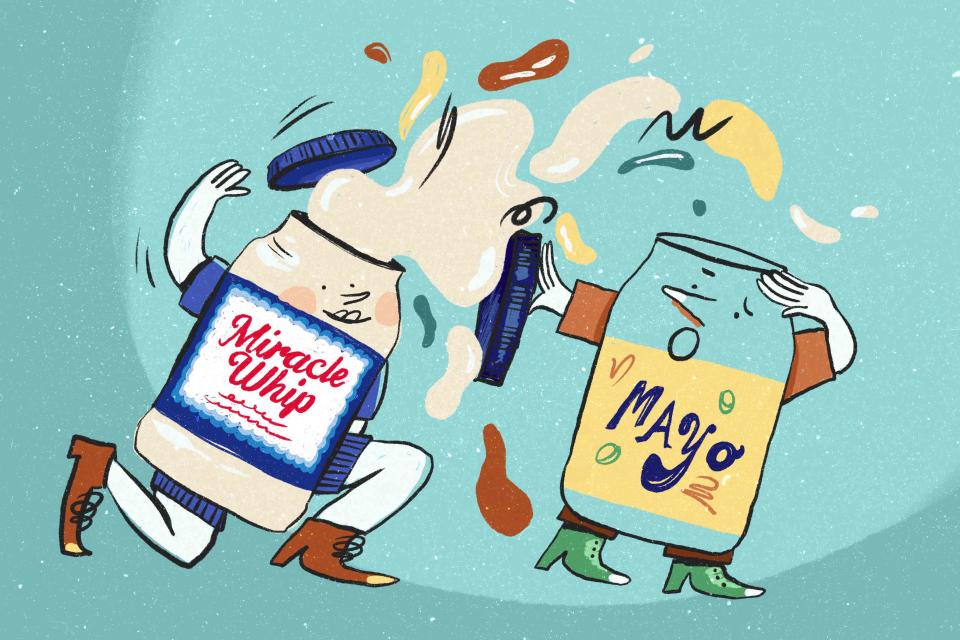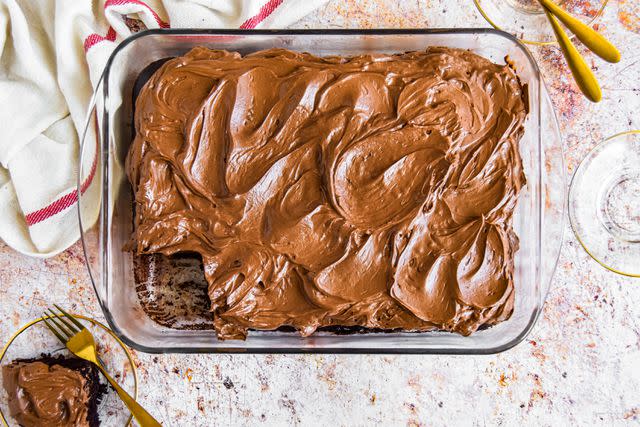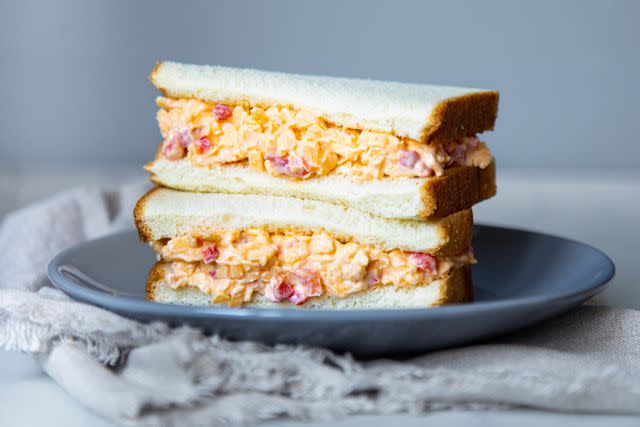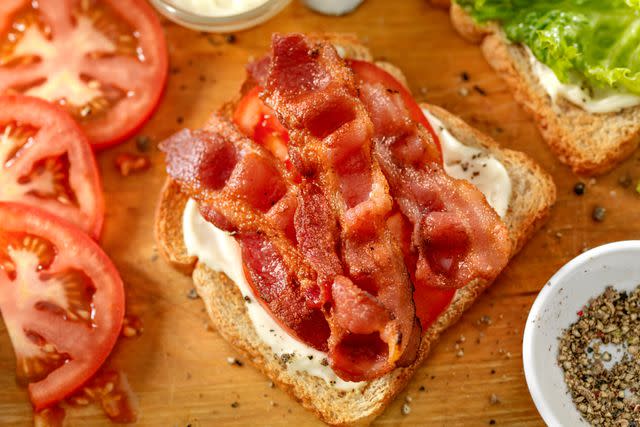Mayo vs. Miracle Whip: The Experts Weigh In
Here's the difference between the two spreads—plus arguments in favor of each of them.

Simply Recipes / Dovile Kacerauskaite
Recently, I told a friend I was working on a story about mayonnaise and Miracle Whip. At the mention of Miracle Whip, she wrinkled her nose and said, "Yuck!" Then she asked me, "What even is Miracle Whip?"
This is not the only time I've seen this negative reaction to Miracle Whip—including from those who have never tasted it and don't even know what it is.
Mayonnaise and Miracle Whip look almost identical and are sold side by side at the supermarket. So why are some people—including mayo lovers—so anti-Miracle Whip? Presumably, it goes the other way around: There are people who love Miracle Whip and dislike mayo. So what's the real difference between the two, and why do people have such strong feelings about them? Let's dive in.
The Difference Between Mayo and Miracle Whip
Mayo and Miracle Whip have quite a bit in common. While both homemade mayonnaise and store-bought mayo vary slightly in their ingredients, the two primary ones are oil and egg yolks (or sometimes whole eggs). Mayo typically also contains an acid, such as vinegar and/or lemon juice, salt, and sometimes sugar and other seasonings.
To be labeled "mayonnaise," the FDA requires a product to be an "emulsified semi-solid food" made from vegetable oil, an acidifying ingredient (vinegar, lemon juice, and lime juice are all allowed here), and an "egg-yolk containing ingredient" (liquid egg yolks, frozen egg yolks, dried egg yolks, and various forms of whole eggs all qualify). In addition, it must have no less than 65% vegetable oil.
Miracle Whip is a brand of creamy mayo-like spread that was introduced during the 1933 World's Fair, according to Kraft-Heinz's website. Like mayo, Miracle Whip contains oil, an acid (vinegar), and eggs. It also contains high fructose corn syrup, mustard powder, paprika, dried garlic, and "spice." Kraft-Heinz labels Miracle Whip as a "dressing," but it's spreadable like mayo.
To me, the most notable taste difference between Miracle Whip and most store-bought mayo is that Miracle Whip is sweeter.

Simply Recipes / Annika Panikker
In Defense of Miracle Whip
I asked several food experts where they land on the debate between mayo and Miracle Whip, and I found fans of both.
Weighing in for Team Miracle Whip is Ann Taylor Pittman, a James Beard Award-winning food writer, recipe developer, and cookbook author—the latest is The Global Pantry Cookbook, coauthored with Scott Mowbray.
"I grew up eating Miracle Whip as our house 'mayo' and always associate it with cold ham sandwiches packed in a cooler for road trips," says Pittman, who was born in and grew up in Mississippi and now lives in Birmingham, Alabama.
"Well, that and the canned pear 'salad' my grandmother would make by dolloping Miracle Whip into a pear half and topping with a maraschino cherry."
Pittman loves traditional mayonnaise, but for certain recipes, it has to be Miracle Whip. "It has a sweeter flavor than mayo and is my go-to for Waldorf salad, any baking recipe (like chocolate cake) that calls for mayonnaise, or sandwiches made with thick slices of leftover holiday ham," she shared.

Simply Recipes / Lori Rice
In Praise of Mayo
Weighing in for Team Mayo is Breana Lai Killeen, a chef, recipe developer, dietician, and farmer at Killeen Crossroads Farm in Vermont, who grew up in North Carolina.
"Let’s start with the fact that I have a lot of opinions about mayonnaise because I think it’s the best condiment and I’ll argue it with anyone," says Killeen. "Growing up in the South, there’s only one type of mayo that has a cult following and that’s Duke’s," the South Carolina mayonnaise brand that's made with no added sugar, unlike mayos made by Kraft, Hellmann's, and Kewpie.
"But I’m Asian, so I also grew up eating a lot of Kewpie. My first restaurant job was at a place that did pimiento cheese and deviled eggs, so that was my first taste of Hellman’s. Admittedly, I never knew about Miracle Whip until starting to work in a test kitchen where we had people from the Midwest and Texas who grew up on Miracle Whip."
"When you taste Miracle Whip vs. mayo, the difference in flavor is distinct," Killeen adds. "The mayo has more weight on your tongue and the Miracle Whip tastes sweeter. Since I’m always a savory over sweet person, I always use mayo."
A Case for Just Using What You Like
For food writer, recipe developer, and creator of The Real Recipes, Adam Dolge, a predilection for mayo is nothing more than a preference—not a moral stance.
"I grew up in a mayo household, specifically Hellmann's Mayonnaise," says Dolge, of the Syracuse area in upstate New York. "My mom put it on our sandwiches, served it as a dip for roasted potatoes, and swirled it into pan sauces. I have happy memories of eating a sandwich with freshly picked tomatoes and a big smear of mayo."
"I have less pleasing memories of eating overly sweet tuna salad sandwiches and choking down odd-tasting coleslaw [that had Miracle Whip,] at a buddy's house. But I never really considered myself anti-Miracle Whip." "
It took many years before I tried different brands of mayo. Most recently, after living in Birmingham, Alabama, I tried and grew to love Duke's Mayonnaise. It has a distinct tang, it's super creamy, and there isn't a hint of sweetness like there is Hellmann's Mayonnaise. I guess when it comes down to it, regular mayonnaise (any brand, really) will always be my preference. But, it's just that, a preference. I prefer less sweet, tangier mayonnaise as opposed to a sweeter alternative like Miracle Whip."
Killeen concurs: "I feel like it’s about brand loyalty more than anything with mayo!"

Simply Recipes / Lauri Patterson
Use What Fits the Recipe Best (or You)
I grew up in North Carolina with a mother from Louisiana and a dad from Michigan. We were a mayo household and used it on sandwiches, in salads, and mixed with mustard to slather on burgers. I have been an unabashed mayo lover all my life, but I wasn't sure whether I had eaten Miracle Whip.
So I got myself a jar and tasted it side-by-side with mayos from Hellman's, Sir Kensington's, and Kewpie. And here's the thing—they all tasted great!
Miracle Whip is sweeter than other mayos, as is Kewpie, so—like Pittman—I think it's best for sweeter dishes, such as macaroni salad or perhaps a BLT. I also tried it swirled into sweet-and-spicy sriracha, dolloped on tomatoes, which was delicious. I'm smearing the combo on salmon and rice bowls, french fries, and sandwiches next.
The Takeaway
Whether you were raised on mayonnaise or Miracle Whip, it's worth putting aside brand loyalty and giving the other spread a try. There's room in my heart for both mayo and Miracle Whip—though my fridge is getting a little tight with all the condiments.
Read the original article on Simply Recipes.

